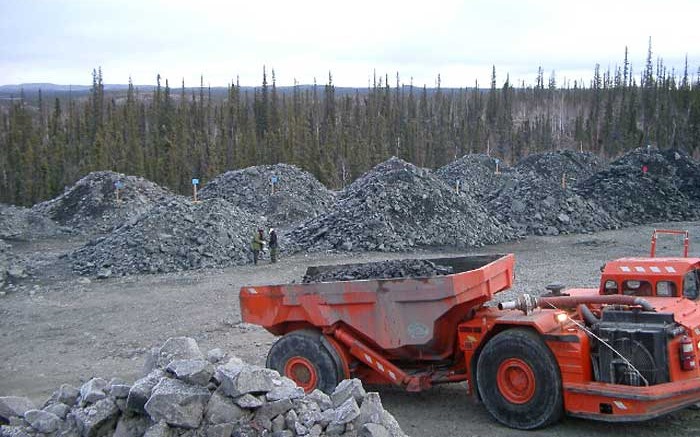Procon Resources, a Vancouver-based mining contractor that is majority owned by China CAMC Engineering, is making an $11.7-million strategic investment in Fortune Minerals (TSX: FT) at a price of 40¢ per share — a 14% premium over Fortune’s June 26 closing price of 35¢. China CAMC is a Beijing-based provider of international engineering, procurement and construction services.
Fortune will use the proceeds to advance its NICO gold-cobalt-bismuth project in the Northwest Territories. Fortune and Procon have also agreed to work together to advance NICO and start construction there next year. Procon conducted underground test mining at NICO in 2005 and 2006.
NICO, 160 km northwest of Yellowknife, is an iron oxide copper-gold deposit, with open-pit and underground resources that are expected to sustain a planned mill throughput rate of 4,650 tonnes per day for nearly 20 years.
Proven and probable reserves for both underground and open pit total 33 million tonnes grading 1.02 grams gold per tonne, 0.11% cobalt, 0.14% bismuth and 0.04% copper.
NICO’s total contained metal adds up to 1.09 million oz. gold, 82.3 million lb. cobalt, 102.05 million lb. bismuth and 27.18 million lb. copper.
The ore at NICO is hosted in three lenses of brecciated ironstone up to 1.3 km long, 550 metres wide and 70 metres thick.
Fortune calculates that $110 million has been spent so far on the project to delineate the deposit and carry out front-end engineering and design studies by Jacobs Minerals Canada and others, and complete underground test mining and several pilot plant tests.
A hydrometallurgical plant in Saskatchewan will process the concentrates from NICO into high-value products.
Fortune has acquired buildings and equipment from the Golden Giant mine at Hemlo, Ont., which were dismantled, moved and stored for relocation to NICO.
The plant will produce gold doré, cobalt sulphate and/or cobalt cathode, bismuth ingot and copper-metal precipitate.
The mine plan foresees the processing of ore in two stages. At site, an average of 4,650 dry tonnes per day of ore would be processed in a crushing, grinding and flotation concentrator to produce about 180 tonnes of wet-bulk concentrate a day.
The bulk concentrate would be trucked to Hay River in the Northwest Territories and then conveyed by CN rail to the Saskatchewan plant near Saskatoon. There, the bulk concentrate would undergo more grinding and flotation to produce separate gold-bearing cobalt and bismuth concentrates.
According to Fortune, the high concentration ratio of NICO’s ore is a big attribute because it helps the company transport high-value concentrate to southern Canada, where it can save on processing costs and use lower-cost power, at about 5.7¢ per kilowatt hour.
Other factors that prompted the Saskatchewan decision included “the proactive support of the government of Saskatchewan,” a five-year tax holiday and the proposed plant’s location near Saskatoon, which gives the company access to rail, the Trans-Canada Highway, natural gas, lime and other reagents, and a labour pool of engineers and process plant workers.
Russell Stanley of Haywood Securities in Toronto notes that Saskatchewan has a “tax environment supportive of processing raw materials sourced from out-of-province,” and a “buy” rating on the stock.
In a research report the mining analyst points out that cobalt “offers investors a play on battery demand growth (both lithium ion and nickel metal hydride), and bismuth is a play on lead-replacement initiatives in a number of industrial and electronic applications.”
Stanley estimates the mining project in the Northwest Territories and the processing plant in Saskatchewan will be fully permitted within the next six months, with initial production targeted for 2015.
In January, the Mackenzie Valley Review Board concluded its environmental assessment and recommended approval of the proposed mine and mill, concluding that a full environmental review of the project wasn’t needed, and that it should proceed to the regulatory phase for approvals.
The results of a front-end engineering and design study in 2012 based on a vertically integrated mine and mill put capital costs at $440.5 million.
The study estimated that life-of-mine average revenue would be $194 million per year and life-of-mine average operating costs would be $97 million a year.
It calculated a pre-tax net present value at a 7% discount rate of $308.5 million, and a 14% pre-tax internal rate of return.
At press time the junior was trading at 37¢ per share within a 52-week range of 26¢ to 65¢.
The company has a little over 121 million shares outstanding.


Be the first to comment on "Procon invests $12M in Fortune Minerals"